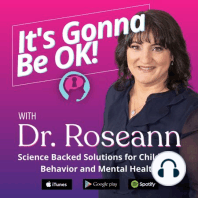4 min listen

133: Child Mood Disorder vs.Typical Behavior
FromScience Backed Solutions for Children’s Behavior and Mental Health
133: Child Mood Disorder vs.Typical Behavior
FromScience Backed Solutions for Children’s Behavior and Mental Health
ratings:
Length:
11 minutes
Released:
Oct 27, 2023
Format:
Podcast episode
Description
Children undergo emotional shifts and behavioral changes as they grow older and navigate the complexities of life. However, there comes a point where these changes may extend beyond the realm of typical behavior and signify a potential mood disorder. That is why it is essential for us to understand the distinction between a child experiencing a mood disorder and displaying typical behavior for timely intervention and appropriate support.In this episode, we recognize and address the challenge of distinguishing between typical childhood behavior and signs of a potential mood disorder in a child as we ensure the well-being of both the child and the parents.Identifying and supporting mood and disrespectful behavior in children.It is important for us to thoroughly explore and understand the distinctions between typical child behavior and the potential onset of mood disorders. This in-depth and holistic understanding is essential in empowering parents with comprehensive knowledge, enabling them to make informed decisions concerning the kind of support and assistance they may require for effectively addressing and nurturing their child.The first aspect that we have to consider in distinguishing typical developmental phases and potential mood disorders in children is the duration and consistency of the behavior. In the case of a standard neurodevelopmental phase, the duration may be prolonged, exhibiting a certain level of regularity; however, these traits eventually subside over time. For instance, a 13-year-old transitioning from being a relatively easy-going individual to displaying intermittent flashes of moodiness is a commonplace scenario. Conversely, if such behavioral patterns endure for an extensive period, possibly six months or longer, a deeper examination is warranted. Another critical factor is the intensity of the mood. In normal developmental phases, the intensity of mood swings is noticeably different. While occasional episodes of heightened intensity may arise, they typically abate swiftly, allowing the child to resume a normal state. On the contrary, children with mood disorders grapple with sustained high intensity and find it challenging to recover from these mood fluctuations. This disparity in intensity serves as a significant marker. Lastly, an assessment of the impact on daily functioning is imperative. If the moodiness does not significantly disrupt family relationships or school performance, it may align more with a typical developmental phase rather than a severe mood disorder. Understanding the duration, intensity, and impact on daily life is pivotal in accurately discerning between normal developmental behavior and potential mood disorders in children.Mood disorders in children and teens and what triggers them.It is crucial for us to acknowledge and address the numerous challenges that parents encounter when their child's moodiness begins to interfere with their interactions and relationships with peers. These challenges necessitate our emphasis on the timeliness of intervention and the imperative of providing the child with essential emotion management skills. By recognizing and acting upon these challenges, we can ensure a supportive and nurturing environment for both the child and their interactions with peers, thus facilitating healthy emotional development and enhanced social connections.Physical symptoms' duration and intensity, especially stress and sleep issues, are noted as indicators of potential mood disorders. Moreover, thoughts and perceptions, such as hopelessness and catastrophic thinking, play a major role in children with mood disorders. Historical and genetic factors contributing to mood disorders, along with the prevalence of misdiagnoses, underscore the need to consider mood disorders in children struggling with emotional regulation and impulsivity. Various mood...
Released:
Oct 27, 2023
Format:
Podcast episode
Titles in the series (100)
It's Gonna Be Ok! by Science Backed Solutions for Children’s Behavior and Mental Health